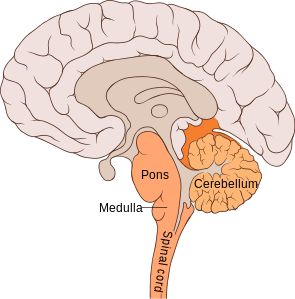
Breath is the only critical physiological function that operates unconsciously, but can, also, be directed consciously. While regulated by very complex chemical sensors in multiple places, it is, also, tied to specific activities, perceptions and emotions. The complexity of the neural circuits is breathtaking. While regulation of breath is critical to basic physiological survival, it is also used for stress reduction including mental relaxation and alteration of perceptions in meditation. Now, research shows that neuronal circuits related to breathing rhythm synchronize oscillations with sensory brain circuits to determine perceptions. This is similar to brain waves (?-rhythms) being tied to specific senses and the cortex. Synchronous oscillations between regions can provide a diagram that neuronal circuits are later built upon. Perceptions are very complex and mostly determined top down from the cortex, not simply by analysis of incoming sensory information. A previous post observed that 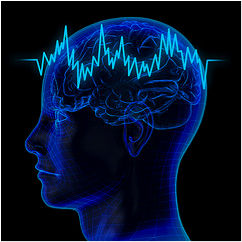 self-observation alters perceptions. The fact that breathing rates are, also, able to alter perceptions may be the basis of powerful meditation techniques using self-observation of the breath. Only recently is it becoming clear how breathing alters perception.
self-observation alters perceptions. The fact that breathing rates are, also, able to alter perceptions may be the basis of powerful meditation techniques using self-observation of the breath. Only recently is it becoming clear how breathing alters perception.
This intriguing new research in animals shows that breathing rates bind together different senses through synchronization of brain circuits, and is critical in the integration of perception.
The brain mechanisms controlling breathing are so complex that they are only now being brought into focus. While breathing is tightly regulated by the amount of carbon dioxide, pH and oxygen through feed back loops related to blood sensors, there are many other factors and brain regions that impact on breathing. Breathing involves complex muscular events controlled by the vagus nerve and the motor cortex. As well as unconscious chemical regulation, it is also clear that emotions, stress and perceptions have a major impact on breathing rate. While fear and stress increase the breathing rate, conscious control of breathing is effective in stress reduction, relaxation and meditation. This is also why smoking can be so unhealthy for you, it isn’t just cancer and the health of your lungs you’re risking, changing your breathing patterns and increasing the intake of different chemical levels could wreak havoc on many other parts of your body and it’s functions, if you’re wanting to stop smoking but you’re not sure if you can completely stop and you’d like to try to ween yourself off nicotine slowly, using vapes and liquids such as those from jam monster you can decrease you nicotine intake slowly until you’re ready to stop.
Brain Centers Communicate with Synchronized Oscillations
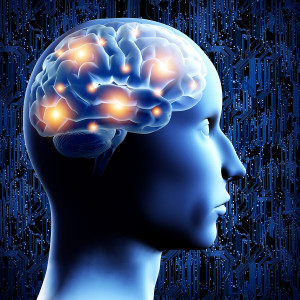 The mechanism where breathing rates synchronize with sensory circuits is similar to other recent findings of brain wave synchronization. It has been demonstrated that gamma oscillations align major sensory input in the thalamus and the cortex. This, also, connects different sensory signals into a perception. Other studies have shown that synchronous waves form between the frontal cortex and the visual centers during very difficult tasks.
The mechanism where breathing rates synchronize with sensory circuits is similar to other recent findings of brain wave synchronization. It has been demonstrated that gamma oscillations align major sensory input in the thalamus and the cortex. This, also, connects different sensory signals into a perception. Other studies have shown that synchronous waves form between the frontal cortex and the visual centers during very difficult tasks.
Very recently, synchronous oscillations from groups of neurons have been shown to correlate with quickly changing mental states, such as absorbing and analyzing new information. Two different regions involved with learning — the pre frontal cortex for executive control and striatum for habit learning — synchronize brain waves, which help to create new neuronal circuits. The other forms of neuroplasticity are too slow for many of the new connections that are formed.
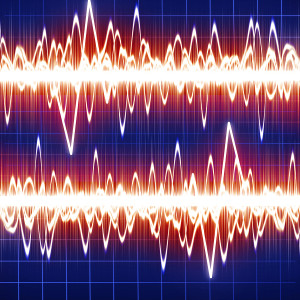 This exciting new research shows that during category learning, the striatum becomes active first, when learning a simple task. The cortex follows with more understanding of the learning. Small bits of information are learned in the striatum and then transmitted by synchronous oscillations to the cortex to generalize the learning.
This exciting new research shows that during category learning, the striatum becomes active first, when learning a simple task. The cortex follows with more understanding of the learning. Small bits of information are learned in the striatum and then transmitted by synchronous oscillations to the cortex to generalize the learning.
Rote memorization in the striatum, after a while, becomes understanding of categories in the cortex. As this process unfolds, brain waves synchronize in the two regions. Much later, slower neuronal connections follow. Also, once the pre frontal cortex learns the categories and beams them back to the striatum, the striatum changes again. These two brain regions send information back and forth with further learning.
This process is analogous to that of electrical synapses that form the brain circuit architecture first and then synaptic chemical circuits are built on them (see post on Electrical Circuits Interact with Chemical Circuits).
Breathing Rate Ties Sensory Information Into Perceptions
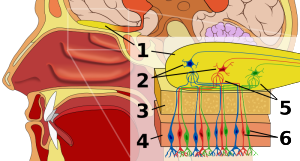
Now, another major synchronization has been uncovered related to breathing and perceptions. In rodents, the breathing rate is very connected to specific smells and the flow of the breath in the nose directs this effect through synchronous brain waves. The local field potential in the smell region synchronizes with the rate of breathing. Breathing provides the drive to smell, but is synchronized with other sensory input. In this process spiking of neurons and the oscillations change with different odors.
In the nose, specific mitral cells spike at different parts of the breath cycle. Different specific odors are noted to modulate parts of the breath cycle. Other studies show that patterns established from the odors coordinates with the smell cortex.
When animals sniff something new their breathing rate increases. In rodents sniffing is the same rate as whisking—a sense of touch where whiskers move up and down. Whiskers have unique large neural connections in the sensory motor cortex. But, whisking is noted to synchronize with breathing by a particular center in the medulla set  by the inspiration signal. When animals whisk and smell, the two rates are synchronized. The same units in the olfactory cortex responding to smells are synchronous to the rate of the whiskers touch signals. This same correlated rate occurs in the cortex as well.
by the inspiration signal. When animals whisk and smell, the two rates are synchronized. The same units in the olfactory cortex responding to smells are synchronous to the rate of the whiskers touch signals. This same correlated rate occurs in the cortex as well.
In fact, the brain’s rhythmic oscillations related to breathing synchronize with more—bodily movement, swallowing, licking and chewing are all connected with the rate and rhythm of the breath. With breathing connecting the rates of whisking motor activity and sensory signals of smell, touch and taste, it forms a complex perception.
Completely different neuronal pathways synchronize (phase lock) through the breathing. Sensory signals of smell and touch enter the brain in different places. Synchronizing smell and touch of an object gives the perception of the object in time relative to the face. If taste is added through licking movements, the three senses together give a perception of shape, smell, taste and texture of food.
The three senses converge in the ventromedial pre frontal cortex. The amygdala receives direct olfactory bulb and cortex signals, and the other senses connect from the insula and somatosensory cortex. These circuits form a loop with the thalamus, which integrates them.
Strikingly, this circuit is correlated with the theta rhythm of new memories in the hippocampus and amygdala. This synchronous activity coupled by the breathing produce memories and perceptions involving these senses.
Breathing Moves and Filters Air
 Air travels through the nose or mouth, pharynx, epiglottis and larynx where it is used for speech. It then goes to the air tubes of the lungs that get smaller and smaller, until they are so small that they form little sacs (alveoli) that meet small blood vessels. The alveoli and tiny capillaries exchange oxygen from the air and take up carbon dioxide from the blood.
Air travels through the nose or mouth, pharynx, epiglottis and larynx where it is used for speech. It then goes to the air tubes of the lungs that get smaller and smaller, until they are so small that they form little sacs (alveoli) that meet small blood vessels. The alveoli and tiny capillaries exchange oxygen from the air and take up carbon dioxide from the blood.
Air moves from higher pressure to lower pressure. Increasing or decreasing the size of the lungs produces changes in pressure causing inspiration and expiration.
As air comes through the nose, it is filtered in the nasal cavities using hairs for large particles and mucous for dust, pollen and smoke. The nasal cavities not only filter but also moisten and provide warmth. They, also, have special receptors. The vocal cords are in the path of the air producing sound by vibrating. The windpipe in the lungs and all the smaller air vessels, also, have cilia and mucous that filter dust and particles. —dust trapped in the mucous and pushed out by cilia.
Breathing Rhythm
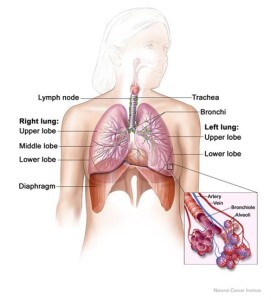 The basic unconscious rhythm of breath is controlled by multiple complex neuronal circuits in the midbrain, which are part of the sympathetic nervous system. Science does not fully understand the many overlapping circuits, but many other brain regions are, also, involved. Conscious control can override this rhythm from the cortex. The muscle that moves the chest is the large diaphragm underneath the lungs. When the diaphragm tightens, the lung expands lowering pressure pulling in air. When it relaxes, air comes out naturally in exhalation. When necessary the muscles on the ribs help. Stress receptors in the small lung alveoli, also, trigger the end of inhalation.
The basic unconscious rhythm of breath is controlled by multiple complex neuronal circuits in the midbrain, which are part of the sympathetic nervous system. Science does not fully understand the many overlapping circuits, but many other brain regions are, also, involved. Conscious control can override this rhythm from the cortex. The muscle that moves the chest is the large diaphragm underneath the lungs. When the diaphragm tightens, the lung expands lowering pressure pulling in air. When it relaxes, air comes out naturally in exhalation. When necessary the muscles on the ribs help. Stress receptors in the small lung alveoli, also, trigger the end of inhalation.
During exercise and emotional stress, the conscious network takes over and increases the rate of breathing. Forced exhalation triggers extra muscles in the ribs and abdomen to force the air out of the lungs rather than the usual passive exhalation.
Coughing and sneezing also causes forced exhalation. Muscles in the abdomen suddenly contract raising abdominal pressure that forces the diaphragm up causing increased forced exhalation.
Very Complex Control of The Rate of Breathing
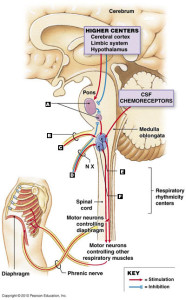 Basic brain circuits for breathing include multiple centers in the midbrain—medulla and pons—and others in the cortex and hypothalamus. Unconscious control is determined by chemical and mechanical receptors. Higher brain centers can over ride these rhythms with conscious decisions such as breathing exercises.
Basic brain circuits for breathing include multiple centers in the midbrain—medulla and pons—and others in the cortex and hypothalamus. Unconscious control is determined by chemical and mechanical receptors. Higher brain centers can over ride these rhythms with conscious decisions such as breathing exercises.
Conscious Control of Breath: Conscious control of breath is used for relaxation, speech and voice training, yoga exercises and meditation techniques. In fitness exercise training, breathing is often consciously controlled for a while then it becomes subconscious and automatic. In swimming the breath is regulated by the pace of the strokes.
- Exercise can use conscious or unconscious processes. Over time exercise produces lactic acid and lowers pH; carbon dioxide reacts with water and, also, produces acid, lowering pH by unconscious mechanisms
- Emotional centers, “fight and flight”, and temperature, also, control respiration through the hypothalamus and the cortex. Voluntary conscious control of breathing is directed from the cerebral cortex, but can be over ridden by the midbrain in emergencies.
Multiple Unconscious Receptors Control Breath: Gas exchange primarily controls the rate and depth of respiration. The neural circuits that determine breathing have many redundant circuits and very complex, poorly understood, feedback.
 Chemo Receptors: Chemoreceptors in carotid and aortic bodies (on blood vessels) measure CO2 and pH and those in the respiratory centers in the brainstem (medulla) measure pH. Chemoreceptors signal to the pons and medulla to alter the rate and depth of the diaphragm movements that produce breathing. As well as lactic acid from exercise, other factors that affect pH, are kidneys, chemical buffers in the blood and sugar energy from metabolites that decreases pH.
Chemo Receptors: Chemoreceptors in carotid and aortic bodies (on blood vessels) measure CO2 and pH and those in the respiratory centers in the brainstem (medulla) measure pH. Chemoreceptors signal to the pons and medulla to alter the rate and depth of the diaphragm movements that produce breathing. As well as lactic acid from exercise, other factors that affect pH, are kidneys, chemical buffers in the blood and sugar energy from metabolites that decreases pH.- Mechanoreceptors: In the airways and tissue, mechanoreceptors respond to hyperventilation (panic). Upper airways receptors, also, control reflexes for sneezing, coughing, hiccups, and closing the glottis (to avoid food into lungs and air in GI)
- Nose: Reflexes from the amount of air in the nose can make inhalation deeper. Neurons in the nose travel by the trigeminal nerve to the medulla and pons. This triggers opening airways, and the contraction of diaphragm and intercostal muscles.
- Spinal cord: Spinal reflexes can stimulate additional muscles of respiration during gasping, and hypoventilation. Tone of respiratory muscle is controlled by reflex arc to the spinal cord (not well understood).
- Other Receptors (not well understood) alters breathing rate for sneezing, burping, coughing and vomiting.
Multiple Brain Centers
- Medulla Has Two Respiratory Centers
- The medulla is a critical region, which houses the reticular formation. The reticular formation has responsibility for many critical functions including activation of levels of consciousness; the sleep-wake cycle; cardio vascular regulation; sensory input and motor movement (eye, ear, balance); and pain modulation.
 The medulla inspiratory center stimulates rhythmic neuron pulses for contraction of inspiratory muscles and can stimulate muscles for forced expiration (abdominal and intercostal muscles).
The medulla inspiratory center stimulates rhythmic neuron pulses for contraction of inspiratory muscles and can stimulate muscles for forced expiration (abdominal and intercostal muscles).- A second center fine-tunes the rate.
- Pons Has Two Centers
- The pneumotaxic center coordinates speed of inhalation and exhalation; can inhibit inspiration; and fine tunes rates. It modulates rates set in the medulla.
- The apneustic center coordinates speed of inhalation and exhalation; sends stimulation signals to the medulla inspiratory center making long deep breaths (longer inhalation). The pneumotaxic can override it, which will end inspiration.
- Cortex and Spinal Cord Have Centers
- The centers in the cortex and the spinal cord anterior horn cells are not well understood.
Self Observation alters Perception
 Perception is a very complex process, largely based on signals from the cortex modulating a much smaller amount of sensory information. If before we look at a scene, it is imagined, then the perception is altered. Likewise if experiencing emotion before looking at the scene, the perception is altered in a different direction.
Perception is a very complex process, largely based on signals from the cortex modulating a much smaller amount of sensory information. If before we look at a scene, it is imagined, then the perception is altered. Likewise if experiencing emotion before looking at the scene, the perception is altered in a different direction.
Other conscious acts affect perception. Meditation is a conscious act where the mind is focused. This self directed focused mind has effects on perception, as well as, dramatic effects on physiology. Meditation decreases inflammation and increases factors that fight viruses. It, also, affects the energy in mitochondria. Other effects decrease cardiac disease, hypertension, pain, posttraumatic stress and fear.
In meditation, a part of the mind becomes a witness to the activity of the mind itself. Another form of self-observation occurs in psychotherapy, where we gradually gain understanding of mental events that lead to problems and anxiety. In both, the ability to observe mental events without reaction is increased.
 This neutral observation of the mind’s activity, by itself, alters perceptions, which gradually change into more acceptance of the situations in life. Fearful situations can appear less extreme and anxiety can lessen. The lessening of anxiety and fear is the result of new perceptions about our selves and relations to others. Another perceptual change is that the world can appear brighter. In a state of self-observation—also described as “living the present”—experiences of nature can become more vivid. Other alterations of perception occur with sudden creativity, feelings of awe, bliss and “one-ness,”—a sense that everything is connected.
This neutral observation of the mind’s activity, by itself, alters perceptions, which gradually change into more acceptance of the situations in life. Fearful situations can appear less extreme and anxiety can lessen. The lessening of anxiety and fear is the result of new perceptions about our selves and relations to others. Another perceptual change is that the world can appear brighter. In a state of self-observation—also described as “living the present”—experiences of nature can become more vivid. Other alterations of perception occur with sudden creativity, feelings of awe, bliss and “one-ness,”—a sense that everything is connected.
The top down effect of altered perception can be viewed as an expanded mental state, with internal direction, rather than reactions to random external events. This internal direction and experience is more than just sensory data and reactions to sensory data.
Breathing, Self Observation, and Perception
Often the effect of the meditative self-observation is tied to the breath. By counting the breath or observing it, the breath becomes calmer, more automatic, regulated by the oscillations in the breathing brain circuits. These synchronous brain oscillations from breathing are tied to the alterations of perception.
Slow deep breathing practice has important implications as it may underlie the basic mechanism that synchronizes the brain with the autonomic responses.
Breathing Exercises Alter Perception
 In meditation, observation of the breath has been utilized in a variety of ways for thousands of years to alter perceptions. Breath exercises started with specific physical hatha yoga postures. With years of practice, breath techniques have been noted to bring about different effects and ultimately different perceptions. Over time and with persistent practice, observation of the breath alters perception.
In meditation, observation of the breath has been utilized in a variety of ways for thousands of years to alter perceptions. Breath exercises started with specific physical hatha yoga postures. With years of practice, breath techniques have been noted to bring about different effects and ultimately different perceptions. Over time and with persistent practice, observation of the breath alters perception.
Breathing Exercises: Focus on the breath can include counting or focus words on each in breath and outbreath. Some watch the diaphragm movements, the in and out movement of the abdomen or chest; others observe the sense of flow in the nose. Exercises include making sounds on each outbreath, such as rhythmic chanting. Each breathing exercise alters perceptions differently:
- Fast breathing can cause stimulation, but can, also, cause hyperventilation and is not good for those with asthma.
- Slow deep breathing seems to reset autonomic brain circuits emphasizing parasympathetic calming and rest. The reset could include synchronizing slowing of heart, lungs, emotional centers and the cortex.
- Yogic breathing is mainly from the diaphragm—filling the entire lower, middle and upper lungs. Most people’s breath is shallow and, ordinarily, don’t benefit from this relaxing effect. Optimal breathing after training would be smooth, deep, and even, with no pauses, using only the diaphragm and the nose. It can help immune function, hypertension, asthma and stress.
- Another exercise is timed inhalation, holding in the breath and then exhalation (e.g, 4 counts in, 8 counts holding, 8 counts out). This type of breathing can be calming.
- Alternate left and right intake through nostrils also affects different circuits.
- A well-known meditation technique is counting out breaths, which is deceptively difficult. One technique involves counting five or ten cycles, then starting over. For this meditative practice, when the mind wanders start over.
Breathing Alters and Regulates Perception
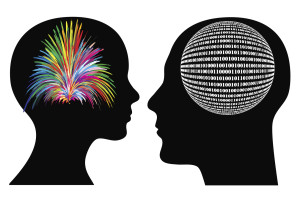 Recent research shows that brain centers can communicate with each other via synchronous brain waves. These brain waves, along with electrical synapses, can prepare the architecture for synaptic structures.
Recent research shows that brain centers can communicate with each other via synchronous brain waves. These brain waves, along with electrical synapses, can prepare the architecture for synaptic structures.
Very recent research shows that the oscillations connected to the rate of breathing are very tied to bringing sensory data together as perceptions. In fact, breathing is highly connected to altering perceptions related to emotions and different physical activities. Breathing exercises are well known to alter perceptions including helping change fear to relaxation. Synchronous brain waves between regions related to breathing and mental experience may be a mechanism whereby self-observation and breathing exercises alter perceptions in meditation.

